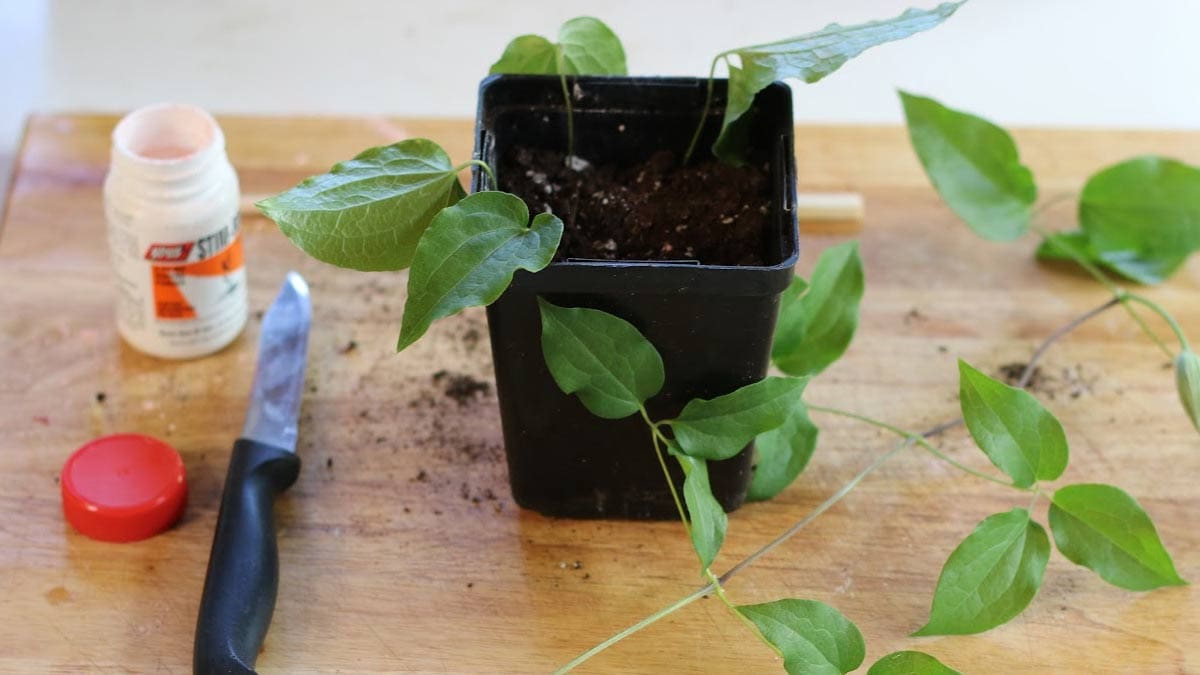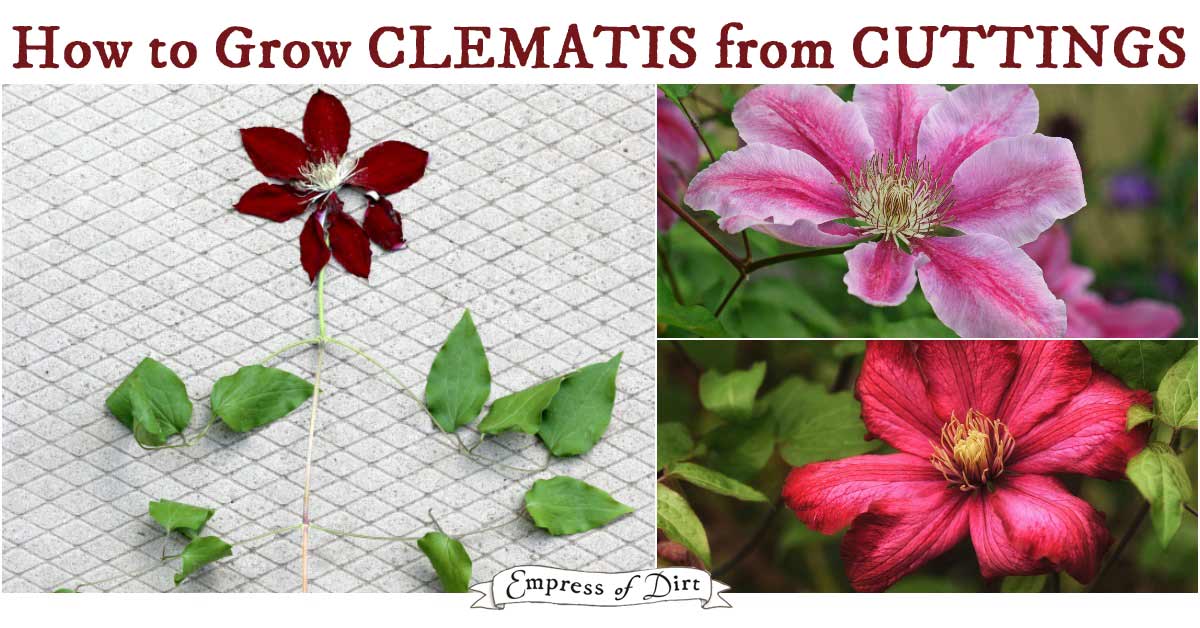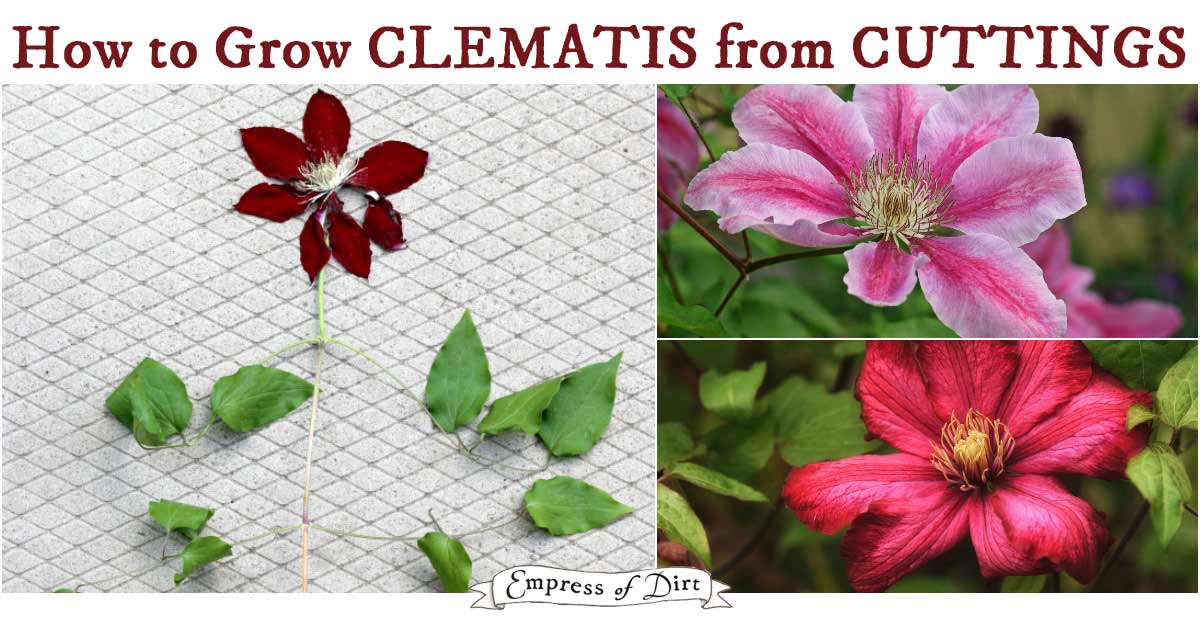The Best Techniques for Growing New Clematis Plants from Cuttings sets the stage for this enthralling narrative, offering readers a glimpse into a story that is rich in detail and brimming with originality from the outset. Clematis, with their vibrant blooms and captivating climbing habits, are a gardener’s delight.
Propagating these beautiful vines from cuttings is a rewarding endeavor that allows you to expand your garden collection and share the joy of clematis with others. This guide delves into the intricacies of clematis propagation, providing a comprehensive roadmap to success.
From selecting the ideal cuttings to nurturing them through the rooting process, we’ll explore every step with meticulous detail. We’ll unravel the secrets of choosing the right time of year, preparing the cuttings, and creating the perfect environment for root development.
By following these techniques, you’ll unlock the potential to cultivate new clematis plants, adding a touch of elegance and vibrant color to your garden.
Choosing the Right Cuttings

Taking cuttings is a popular and effective way to propagate clematis plants. The success of this method depends on choosing the right cuttings from healthy, vigorous plants at the optimal time of year.
Timing of Cuttings
The best time to take clematis cuttings is during the summer months, typically from June to August. This period is ideal because the plant is actively growing, producing new stems that are still pliable but have developed enough to root successfully.
Characteristics of Healthy Clematis Stems
To ensure successful propagation, select cuttings from healthy, vigorous clematis plants that are free from disease or pests. Look for stems that are:
- Green and pliable, indicating active growth.
- Free from any blemishes or signs of damage.
- Growing in full sun or partial shade, as this indicates healthy conditions.
Optimal Length and Number of Nodes
The ideal length for clematis cuttings is between 4-6 inches. This length provides enough nodes (points where leaves grow) for successful rooting. Each cutting should have at least two nodes, and ideally three. The nodes contain the plant’s hormones that stimulate root development.
Selecting Mature, Yet Not Fully Hardened Stems
Clematis stems that are too young may not have developed enough to root effectively, while fully hardened stems are more difficult to root. Aim for stems that are mature but still pliable.
Just like learning the best techniques for growing new clematis plants from cuttings, understanding the process of propagating Venus fly traps from bulbs can unlock a whole new world of gardening possibilities. For a comprehensive guide on propagating these fascinating carnivorous plants, check out How to Propagate Venus Fly Traps From Bulbs: Step-by-Step.
Whether you’re a seasoned gardener or just starting out, mastering these techniques will help you create a thriving and unique garden sanctuary.
- Mature stemsare thicker and have a slightly woody texture.
- Pliable stemscan be bent easily without snapping.
Preparing the Cuttings: The Best Techniques For Growing New Clematis Plants From Cuttings

Once you’ve selected your ideal cuttings, the next step is preparing them for rooting. This involves making clean cuts, removing unnecessary parts, and treating them with rooting hormone to promote root development.
Making Clean Cuts
Using a sharp knife or shears is crucial for making clean cuts. This minimizes damage to the cutting and encourages faster healing and root growth. * Cuttings should be made at a 45-degree angle.This allows for a larger surface area for root development.
- Avoid crushing the stem.Make sure the cut is clean and smooth, free from any jagged edges.
- Use a sharp knife or shears.Dull tools can crush the stem and hinder root growth.
Removing Lower Leaves and Buds
Removing lower leaves and buds is important to prevent rot. These parts are susceptible to decay and can use up energy that could be directed towards root development. * Remove any leaves below the soil line.These leaves will be submerged in the growing medium and are likely to rot.
Remove any buds below the soil line.These buds will use up energy that could be directed towards root growth.
Using Rooting Hormone
Rooting hormone is a powder or liquid that contains plant hormones that stimulate root development. It can be applied to the base of the cutting to encourage faster rooting.* Apply rooting hormone according to the manufacturer’s instructions.Some rooting hormones are powders, while others are liquids.
- Dip the base of the cutting in the rooting hormone.Make sure the entire base is covered.
- Avoid applying rooting hormone to the leaves or stems.This can damage the plant.
Preparing a Suitable Growing Medium
A suitable growing medium is essential for providing the right conditions for root development. It should be well-draining, airy, and sterile. * Use a mixture of peat moss, vermiculite, and perlite.This combination provides good drainage, aeration, and moisture retention.
Propagating clematis from cuttings can be a rewarding experience, allowing you to quickly expand your collection of these beautiful flowering vines. Similar to the ease with which you can multiply your schefflera collection, as detailed in this guide on How to Multiply Your Schefflera Collection Quickly and Easily , clematis cuttings can be rooted in water or a well-draining potting mix, ensuring the success of your propagation efforts.
- Sterilize the growing medium.This will help to prevent diseases.
- Fill pots or trays with the growing medium.Make sure the pots or trays have drainage holes.
Planting and Caring for Cuttings
Once your clematis cuttings are prepared, it’s time to plant them in a suitable environment to encourage root development. Providing the right conditions and care is crucial for successful propagation.
Ideal Conditions for Clematis Cutting Propagation
Creating an optimal environment is key to encouraging root development. Here’s a breakdown of the ideal conditions:
Condition |
Description |
|---|---|
Temperature |
Maintain a consistent temperature between 65-75°F (18-24°C). This warm environment encourages root growth and development. |
Humidity |
High humidity levels are beneficial for clematis cuttings. Aim for 80-90% humidity to prevent the cuttings from drying out. |
Light |
Provide bright, indirect light. Avoid direct sunlight, which can scorch the delicate cuttings. |
Planting Clematis Cuttings, The Best Techniques for Growing New Clematis Plants from Cuttings
When planting your cuttings, choose a well-drained pot or propagation tray filled with a suitable rooting medium. A mixture of peat moss and perlite, or a commercial rooting mix, provides good drainage and aeration.
- Gently make a hole in the rooting medium, deep enough to accommodate the cutting.
- Insert the cutting into the hole, ensuring that the nodes are buried in the medium.
- Firmly press the rooting medium around the base of the cutting to provide stability.
Maintaining Moisture Levels
Consistent moisture levels are essential for successful root development. The rooting medium should be kept evenly moist but not waterlogged.
Water the cuttings regularly, ensuring the entire rooting medium is thoroughly moistened.
Avoid letting the medium dry out completely, as this can stress the cuttings and hinder root growth.
Using a Cloche or Humidity Dome
A cloche or humidity dome can help create an optimal environment for root development. These structures trap moisture and create a warm, humid microclimate around the cuttings.
- Place a cloche or humidity dome over the pot or propagation tray after planting the cuttings.
- Monitor the moisture levels inside the cloche or dome regularly, and mist the cuttings as needed to maintain high humidity.
- Remove the cloche or dome for short periods each day to allow for air circulation and prevent fungal growth.
Rooting and Transplanting

After patiently nurturing your clematis cuttings, the moment of truth arrives: determining if they have successfully rooted. Once established, you’ll need to prepare them for their permanent home in the garden. This section delves into the crucial steps of recognizing successful rooting, hardening off the cuttings, and finally transplanting them into their designated location.
Recognizing Successful Rooting
Observing new growth is the most reliable indicator that your clematis cuttings have successfully rooted. New leaves emerging from the nodes above the soil line signal that the cutting has developed a healthy root system and is drawing nourishment from the soil.
Additionally, gently tugging on the cutting should reveal resistance, confirming that the roots are firmly anchored.
Hardening Off Rooted Cuttings
Before transplanting your rooted clematis cuttings outdoors, it’s essential to acclimate them gradually to the harsher conditions of the garden. This process, known as hardening off, prepares the cuttings for the full sun, wind, and temperature fluctuations they will encounter.
Hardening off involves gradually exposing the cuttings to increasingly longer periods of outdoor conditions. Begin by placing them in a sheltered location for a few hours each day, gradually increasing the duration over a week or two. By the end of the hardening-off period, the cuttings should be able to tolerate full sun and outdoor temperatures for several hours.
Transplanting Clematis Seedlings
Once your clematis cuttings have successfully hardened off, you can transplant them to their permanent location in the garden. Choose a site that receives at least six hours of sunlight per day and has well-drained soil.
Transplanting Procedure
- Dig a hole twice as wide and as deep as the root ball of the clematis cutting.
- Mix a generous amount of compost or well-rotted manure into the soil at the bottom of the hole to improve drainage and provide nutrients.
- Carefully remove the clematis cutting from its pot, ensuring that the root ball remains intact.
- Place the cutting in the hole, ensuring that the top of the root ball is level with the surrounding soil.
- Backfill the hole with the amended soil, gently pressing down around the root ball to remove any air pockets.
- Water the newly transplanted clematis thoroughly, ensuring that the soil is moist but not waterlogged.
Providing Support for Clematis Vines
Clematis vines are vigorous growers and require sturdy support to climb and thrive. The type of support you provide will depend on the variety of clematis and the desired effect.
Types of Clematis Support
- Trellises:These provide a vertical framework for clematis vines to climb, offering a classic and elegant look. Trellises can be made from various materials, including wood, metal, and plastic.
- Obelisks:These tall, pointed structures offer a more dramatic and focal point for clematis vines. Obelisks can be made from various materials, including metal, stone, and wood.
- Arbors:These structures provide a shaded walkway or entrance, ideal for creating a romantic atmosphere. Arbors can be made from various materials, including wood, metal, and stone.
- Fences:Clematis vines can be trained to climb fences, creating a lush and natural screen.
Summary
Growing clematis from cuttings is a fulfilling journey that allows you to witness the miracle of plant propagation firsthand. By understanding the principles of clematis cuttings, you can cultivate new plants with confidence and enjoy the satisfaction of creating your own beautiful clematis collection.
Whether you’re a seasoned gardener or a novice enthusiast, this guide equips you with the knowledge and skills to successfully propagate these enchanting vines. So, grab your shears, prepare your growing medium, and embark on this exciting journey of cultivating new clematis plants from cuttings.
FAQ Insights
What are the best tools for taking clematis cuttings?
A sharp knife or pair of pruning shears are essential for making clean cuts. A pair of tweezers can be helpful for removing leaves and buds.
How long does it typically take for clematis cuttings to root?
Rooting time can vary, but it generally takes 4-6 weeks for clematis cuttings to develop roots.
What are some signs that my clematis cuttings are not rooting properly?
If the cuttings are wilting, turning brown, or showing signs of rot, they may not be rooting properly. Check the growing medium for excessive moisture or dryness.
